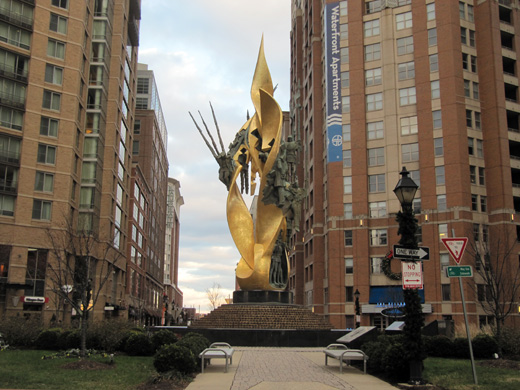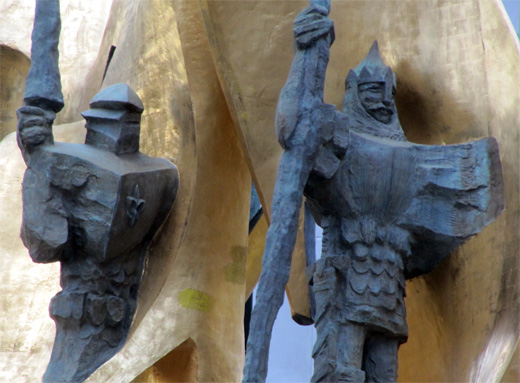Baltimore is a rewarding place to hunt for traces of the Middle Ages, from the extensive collection at the Walters Art Museum to the ersatz medievalism of the Bromo-Seltzer Tower —but a few weeks ago, in a redeveloped circle where the Inner Harbor meets Fells Point, I was struck by a column of burning knights.
Conquistadors? Crusaders? No—they represent something far more serious than I’d expected to find alongside J. Crew, Starbucks, and Haagen-Dazs.

That’s the National Katyn Memorial, designed by sculptor Andrzej Pitynski and dedicated in 2000. It reminds the world that in 1939 and 1940, the Soviets massacred thousands of Polish military officers, most of them reservists—teachers, doctors, priests, rabbis, lawyers, and civil servants who resisted Stalinist indoctrination in prison camps. For decades, the Soviet secret police tried to cover up the slaughter.
Putin’s Olympics are a fitting time to remember the Katyn massacre. You can learn more about it at the National Katyn Memorial website, the National Archives, and the PBS website—but what makes this memorial a suitable subject for this blog is its medievalism.
According to the plaque beneath the sculpture, the 44-foot flame symbolically “envelops the Katyn martyrs . . . and raises them spiritually into the pantheon of national heroes of Poland.” Three Polish officers (including the only known female victim) burn at the base, while other bound victims writhe higher up.
Throughout the flames stand the souls of medieval knights.

On the right is Boleslaw the Brave, the first crowned king of Poland, born in the year 967. Alongside him is Zawisza the Black, the 15th-century knight who died trying to keep the Ottoman Turks out of the Balkans. Elsewhere, you’ll find King Wladyslaw III, who also died fighting the Turks in 1444, plus a few more recent heroes: Jan Sobieski, Kasimir Pulaski, and Tadeusz Kosciuszko.
The Katyn Memorial is sobering, but at 44 feet high, it also conveys heroic permanence. We now expect atrocities to be memorialized through grim slabs of black marble with no features other than the names of strangers, but here, recognizable human figures united by defiant nationhood illustrate an ongoing story of human evil purified by the fires of patriotism.
When medievalism flares in central and eastern Europe, it’s rarely charming: Ossetian separatism, Kyrgyzstani terrorism, Serbian nationalism, royal Ukrainian saints who buried their enemies alive—the list goes on, and it’s not confined to the largely benign medievalism that thrives in the United States.
It’s an old story in Europe: Leaders rally their restless tribes by exploiting their medieval roots. What’s happening in Baltimore is more typical of the way America tempers medievalism: The worst burns away, leaving the laudable goal of simple remembrance.


I didn’t know (or else had forgotten) that there was a memorial to Katyn in Baltimore! Interesting to see. What are the materials?
LikeLike
I believe the figures and flames are bronze, and the fountain base is made of granite. (Unfortunately, my snapshots of the memorial are pretty terrible. The sun was nearly down I and wasn’t sure I’d be back in that neighborhood for a while…)
LikeLike
Suppose a reader were ignorant of almost all things medieval, and suppose that reader were to ask you the following question: “To begin my education about all things medieval, what one or two books should be my initiation?”
BTW: Of course, Becoming Charlemagne is already included in his “must read” curriculum.
Then there is this question: will Europe’s tribal roots eventually wither away, or is the Balkanization more or less permanent?
And then there is this question: do you foresee a revival of another medieval moment — Crusades (i.e., Christians v. Muslims) on a full-scale, international effort?
LikeLike
R.T.: I’ll send you some book recommendations via email when I have a moment. As for your questions: I confess I don’t know. My hunch is that tribalism won’t soon fade away in the Caucasus or the Balkans, but I’ve no idea what the future holds for northern and western Europe. Nor can I say what the future holds for Christian-Muslim conflict. Alas, I’m much better at understanding how mining the medieval past got us where we are than I am at predicting where it’s all going.
In recent years, I’ve used this blog to document what Americans do with the sizable medieval strands in our cultural DNA—in architecture, art, pop culture, politics, religion, and so forth. For the most part, Americans don’t feel burdened by the worst of the Middle Ages the way Europeans do, so we play with medievalism and make it our own, choosing the parts we find useful and disregarding the rest. This tendency is mostly harmless, but some days I can’t help but wonder if we aren’t overdue for a flare-up of uncommonly ugly medievalism in America. We shall see…
LikeLike
Hah, I think my question was easier to answer! Those are hard ones.
LikeLike
Hello– I am the graphic artist and a committee member for the National Katyn Memorial Foundation and am very grateful for such a wonderful article about our monument. Your particular mention, “We now expect atrocities to be memorialized through grim slabs of black marble with no features other than the names of strangers, but here, recognizable human figures united by defiant nationhood illustrate an ongoing story of human evil purified by the fires of patriotism.” struck me, in that we have gotten comments from PC artistic snobs that this visual aspect is overdone sentimentality. Of course, they are wrong, because people connect with the visually familiar. The tendency today, as you pointed out so eloquently, is to dehumanize historic events – to design monuments devoid of emotion, symbolism and historicity. Poland has always retained a very strong bond with its medieval past, and most school children in Poland are very familiar with these historic, heroic figures and their connection through history. When our monument was first erected in 2000, everyone who walked by were very impressed, BUT they all wondered – who are all those different figures and why are they there? After realizing this missing aspect to the site, only later in 2006 did we design and erect the 2 large interpretive panels on either side on the monument describing the 1940 massacre itself, and also the name and history of each figure depicted. Now the public can fully learn not only the World War II story of Katyn, but also its connection to all of Polish history.
LikeLike
And POWs; they were Prisoners of War, those in Katyń and elsewhere–
LikeLike